
MARS SOUTH POLAR
SPOUTS-PLANTS-FORESTS: Part 2
Report #101
April 23, 2006
Click here to return to PART 1
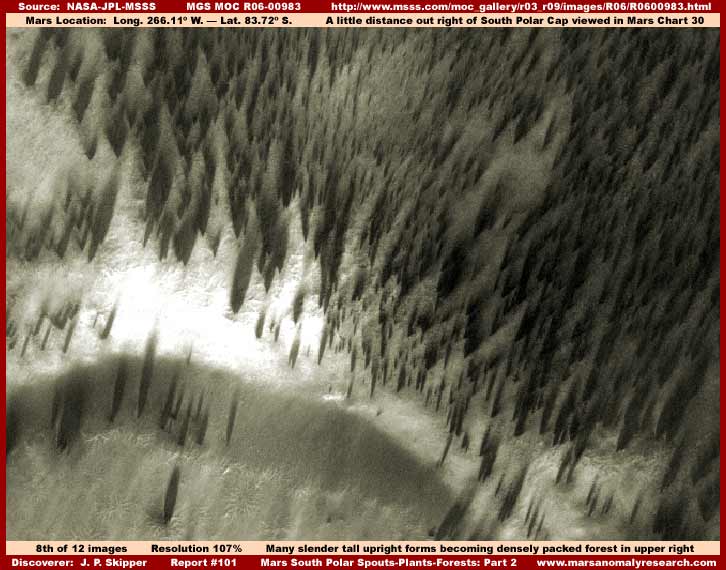
The above eighth image from the R06-00983 strip demonstrates a great deal of tall upright forms in varying sizes with their size, numbers and density intensifying in the upper right of the image constituting a thick forest there. Note that these upright forms appear to be slender and finer textured and most appear to be conical shaped in that they exit from the ground at a narrowly defined point widening in the middle and then narrow a bit at the top very similar to some Earth type fir or cedar trees. On the other hand, note that not all do this as a few appear to continue to widen and spread out more at the top.
Note that all this evidence exits from the ground at a specific narrow point and none show signs of material building up on the ground at the base point. That factor and the presence of increasing sizes clearly implies that these are permanent fixtures growing in the terrain and not some kind of temporary spout or geyser pumping out dark material into the air and onto the ground. Of course these life form could be well past the spout stage and any evidence of that has since disappeared. Note that they also get much thicker and more numerous in a denser pattern forest mode the further they go into the upper right corner of the image. It is more of the same in the original science data strip not imaged here.
Although this evidence's appearance here may look something like many individual fir or cedar trees and therefore may in fact be some kind of true trees, I must tell you that I have seen what I suspect is far more mature bigger forms of this evidence but merging together forming great combined smoothed sheets and layers that look nothing like this probably beginning stage of development. In fact, what it looks most like (as far as my observational familiarity goes) is underwater colony algae bent over seeming to be in layers. If that visual association turns out at some point to have some merit, then we may not be looking at a true vegetation forest but some form of evolved tall growing algae forest or some hybrid form of algae and vegetation.
Too bad but I can't remember now where I put that more mature evidence imaging and so that type of evidence will not appear here now in this report. On the other hand, what is perfectly clear here is that these slender tall upright forms as seen above, what ever they are, whether spouts or permanent fixed forms, in no way reasonably resemble any kind of natural inanimate solid particulate geology and exhibit every factor of spreading, growing life evidence of some kind. It defies reason that the experts appear to be unable to recognize this very obvious life evidence on Mars for what it clearly is as differentiated from geology.
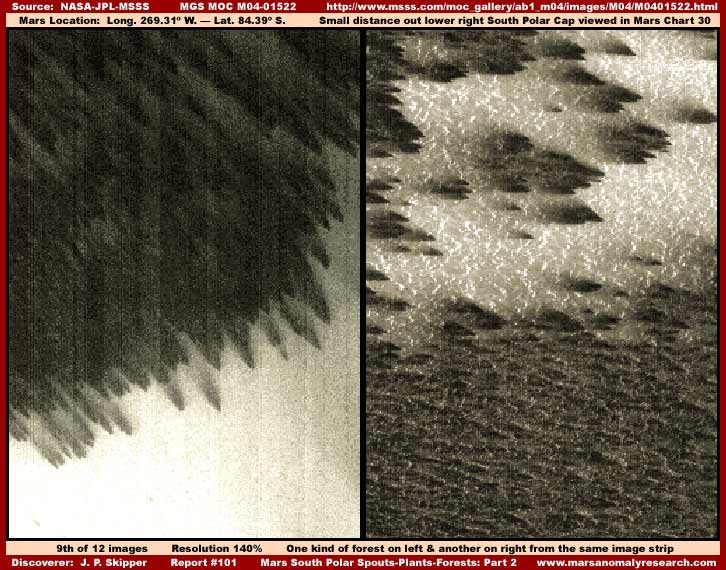
The above ninth split screen image from strip M04-01522 demonstrates in the left field what appears to be taller growing upright form forest evidence similar to that seen in the previous better quality 8th image but more poorly seen here because it is located at the top of a very long data strip where the resolution is poorer. It is a scene about 30% of the way down the strip from the top. The right field image is taken from the same strip but further down about 40% from the top where the resolution is a little better and demonstrates a completely different type of forest form of a lower profile.
It is my suggestion that much of the completely different looking type of forest life evidence as exampled above originates from adaptive colony forms that may far back in time share a common ancestral life form(s) but in adapting to changing conditions over long periods of times since then have evolved differing survival strategies and therefore differences including in outward looks. I strongly suspect that part of their life cycle begins underground as a growing spreading colony form in fluid nutrient solutions and through the process of transference such as spout/geyser processes from a below ground life cycle stage to an above ground stage often physically and dramatically change the very terrain they exist in altering it to facilitate and accommodate their metamorphosis.
If true, note that this kind of evidence is fundamentally different than tree forest life here on Earth most of which begins life as an individual life form seed below ground that immediately strives in reaching for the surface and solar radiation as an individual plant. If ground and atmospheric conditions are favorable and the individual Earth plant survives, it grows and merely displaces some below ground soil as it does so. It does not alter the landscape in any significant way as an individual life form to accommodate and facilitate its struggle for survival.
The reason that I mention this here is because I want you to pay closer attention to the mostly poorly seen visual texture and patterns of the more light reflective terrain geology these Mars living forests exists in and immediately around the individual members. Not just here in this report but in previous reports and future reports and I think that you will gradually begin to see what I'm talking about at work as the evidence accumulates reinforcing this colony life form concept.
However, in doing so, just remember that the smaller size of ground level geological detail or plant covered terrain is not well presented in this distant and obscured satellite imaging and only gross very large forms, changes or alterations can be more easily identified. Please remember as well that light color over saturation of terrain and what ever is on it is a common obfuscation tactic to artificially make it appear as bare geological terrain and that must be taken into consideration as well.
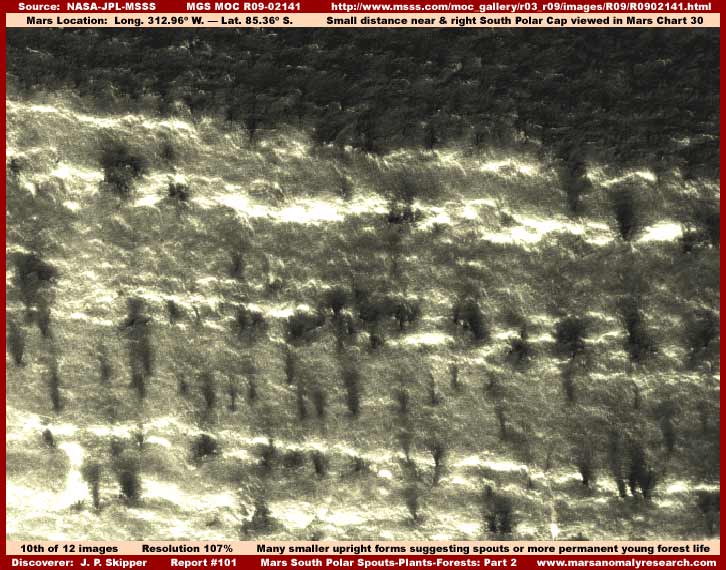
The above tenth poorer quality image evidence sourced from the R09-02141 strip demonstrates more but smaller upright forms again at the edge of darker body of light absorbing forest evidence. These could be smaller spouts or geysers in action but note the lack of build up of dark material around their base. The lack of such visual evidence at the base doesn't necessarily mean that they weren't spouts at some point. It could merely mean that they started out as a colony life spout that is now well past its initial ejection stage and well into the development of a more permanent above ground very upright form that will continue to grow and establish itself from this ground ejection point.
I bring up this point possibility because the darker forest mass behind these upright forms is filled in by mature forms that are much lower profile and entirely different than the previously presented evidence above. Even so, once these forms cover over and fill in the ground space between them forming a carpeting forest covering appearance, their very fine and smooth texture once again visually suggests algae or in this case more like mold. Of course appearances can be deceiving and especially in such poor quality imaging.
But, I also want to draw your closer examination to what one would assume is bare terrain space between the foreground upright forms here in this 10th image. In fact it isn't bare terrain at all, rather it is area covered by some kind of even lower profile carpeting growth. Further, it may be that this is the true life form. Upright forms like this may sometimes be a type of extended height propagation bloom with a prolonged life much like below ground mold as the real life form that produces above ground mushrooms stalks here on Earth except that the real mold growth here is also mostly above ground, just visually very low profile and visually blending in with the terrain that it covers over in this poor quality imaging.
In other words, it may be yet another variation of this colony organism life on Mars that through adaptation over time has evolved into great variety. Once this consideration gets into your head and you mull it over, think about applying it and its potential as a consideration for all of the life evidence presented here in Report #101. If it will help or if you are inclined to dismiss this concept, I can tell you that colony life such as mold, algae, etc. that we might normally expect to see on a tiny organism scale in a lab dish here on Earth have developed differently on Mars into gigantic forms compared to what we are familiar with. You will be seeing more of this gross larger evidence in future reports.
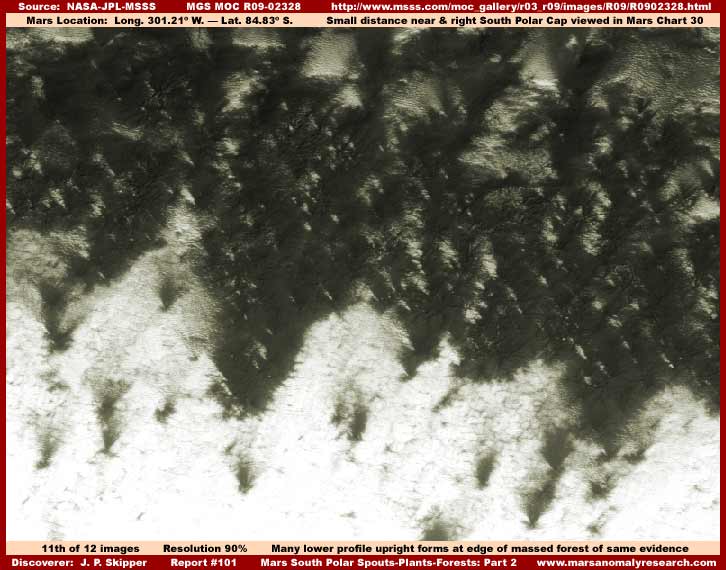
The above eleventh better quality image evidence sourced from the different R09-02328 strip demonstrates either the same or nearly the same type of living evidence as seen in the previous image #9. The difference is that here in this image the individual object evidence can be seen a little better in the darker back area because the evidence is a little scattered having not completely filled in yet and it can be seen that the forest is made up of a great many of these same individual upright forms. Their texture is so fine looking at this satellite imaging distance that when they grow larger and visually merge together they form a smoothed over if lumpy looking top surface that gives the visual effect of looking something like mold.
Further, when the scene backs away to a more distant wide area view not shown here due to image space limitations, this smooth low profile dark color mold looking life evidence orients in long parallel bands. You can see the beginning of this happening in the very dark area at the top of the previous 10th image. These dark bands can cover very large areas in the South Polar Region and appear to fold up the land in parallel rows under them to conform to these bands. Contrary to official explanations, these long huge dark bands are not due to inexplicable Mars geological activity but due to this living growth probably colony life evidence literally altering the terrain under it. The above 11th image evidence provides a rare look at the individual components of this normally obscured forest life evidence and is very important in bringing a little truth to this banding perception and understanding it a little.
One thing is for sure, this above kind of collective but individual forest evidence just simply cannot be confused with any kind of inanimate solid particulate geology. Note the smaller upright forms scattered around in the image foreground's much more light reflective terrain and compare them with the much larger upright darker light absorbing forms in the back near the top of the image. This evidence logically equates to smaller younger forms in the foreground pioneering into new open ground and larger older more established and more mature forms in the back where the forest becomes more dense and that spells growth and life. What could be more obvious than this?
You should know that, although not imaged here, behind this scene's point of view is a densely packed forest of this living evidence completely carpeting and hiding the light reflective terrain from view. It is in wide area banded appearance crossing right across the middle area of the strip and the evidence I've imaged above is on its lower edge. Clearly we are looking at dynamic changing life that in basic behaves as all life does. It is incredibly obvious and yet NASA and JPL science experts either can't seem to see this or perhaps refuse to do so. What is going on with them?
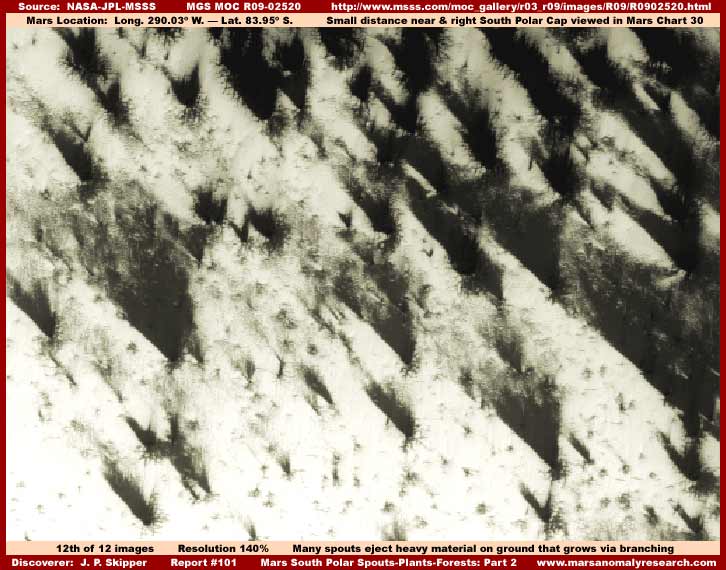
The above twelfth image from the R09-02520 strip demonstrates active spouts in varying sizes shooting out dark material and just about all with dark material plume trails on the ground behind them and to our left probably directionally responding to prevalent wind conditions. As you can see here in this image evidence, the life growth originates all along the plume trail on the ground rather than just from the spout specific origination ground exit point. As you can also see, they grow and spread via many clearly seen branching tendrils in a growing spreading mass all along the exit point and plume trail.
This evidence is located at the top of the strip and that top edge cuts off any view of the forest this is no doubt on the edge of. Although we can't be absolutely sure because we can't see the larger denser forest, the visual evidence we can see logically implies that these life forms will probably be the lower growing and profile forms as opposed to tall upright forms. This is just another example of what I mean about the great variety of this kind of colony life form evidence and its many adaptations and form appearance that tends to confirm long evolution times on the planet with all that concept's implications.
The point is that all the accumulative samples of evidence in this 2-part report demonstrates the relationship of so many of the Mars spouts or geysers with Mars biological living organisms that grow, spread, carpet, cover, engulf, change, and alter large areas of South Polar terrain geology as dynamic changing life not to be confused with inanimate solid particulate geology. It is essential that we begin to understand this about our sister planet and that our larger planetary environment is more complex than we ever imagined. If we are to advance as a race of Earth humans, we must shake our illusions and begin to face greater truths.
Further, once it is understood that Mars may actually be a place of life stable over eons of time quite contrary to the official pabulum handed out to us and sometimes life quite different than our own here on Earth, it is then logical to seriously consider what kind of smaller lower as well as higher forms of life complexity these sometimes familiar and sometimes unfamiliar thick and vast forested ecosystems harbor within them that satellite imaging cannot show us? Certainly these appear to be wild places that may offer Earth humans challenges heretofore undreamed of. Are you ready to explore such concepts?
Click here to return to PART 1
DOCUMENTATION
http://www.msss.com/moc_gallery/r03_r09/images/R06/R0600983.html: This link takes you to the official MGS MOC R06-00983 narrow-angle science data image strip from which my eighth image above was sourced. The evidence I've imaged is about a third of the way down the strip from the top.
http://www.msss.com/moc_gallery/ab1_m04/images/M0401522.html: This link takes you to the official MGS MOC M04-01522 narrow-angle science data image strip from which my ninth split screen image above was sourced. The evidence in the left field is located about 30% down from the top and the right field evidence is located about 40% down from the top.
http://www.msss.com/moc_gallery/r03_r09/images/R09/R0902141.html: This link takes you to the official MGS MOC R06-000983 narrow-angle science data image strip from which my tenth image above was sourced. The evidence I've imaged is about 60%-70% of the way down the strip from the top.
http://www.msss.com/moc_gallery/r03_r09/images/R09/R0902328.html: This link takes you to the official MGS MOC R09-02328 narrow-angle science data image strip from which my eleventh image above was sourced. There is a wide dark band through the middle of the strip with the rest above and below that being light reflective open terrain. The evidence I've imaged is at the bottom edge of that dark band about 70%-80% down form the strip's top.
http://www.msss.com/moc_gallery/r03_r09/images/R09/R0902520.html: This link takes you to the official MGS MOC R09-02520 narrow-angle science data image strip from which my twelfth image above was sourced. The evidence I've imaged is of a small dark area right at the very top edge of the strip.
, Investigator
![]()